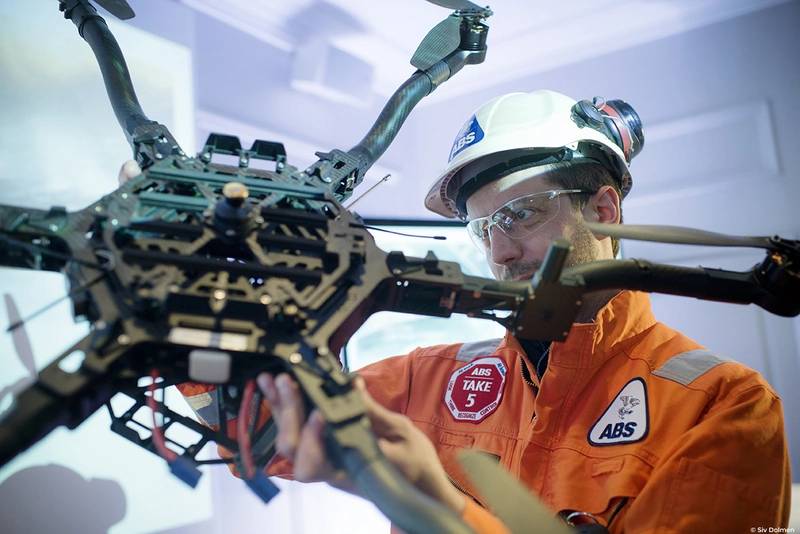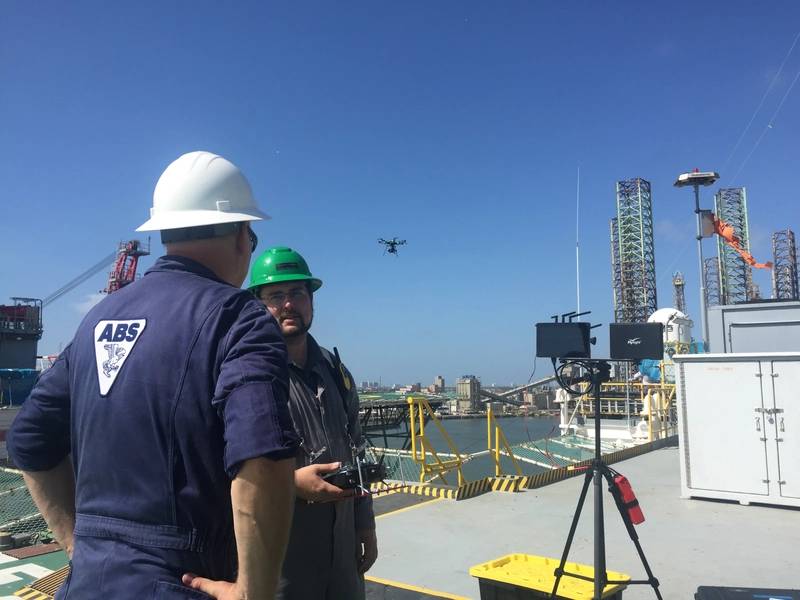The Drones are Coming
Nimble and quick, unmanned aerial vehicles have evolved into a valuable tool for marine and offshore applications.
When a U.S. oil tanker conducts a Critical Area Inspection Plan (CAIP) as required by ABS, it is an onerous process. For example, each tank requires seven days of set up with scaffolding and staging. An ABS inspector and UDT technicians must access, and be carefully lowered into the tank with instrumentation and tools. Inspection points in far reaching places are surveyed. Carried out in the traditional fashion, it can be a difficult, dangerous, time consuming and expensive procedure.
Now, the same tanker is using drones to perform much of this function. A drone inspection can be conducted in about a day. Not all personnel have to be lowered into the tank. There’s no risk of items being dropped (and/or lost) in the tank, and the drone can easily go where it might be otherwise difficult and dangerous for humans to survey within the tank.
Drones for Maritime Applications
Drones have arrived. Using a remote-controlled unmanned aerial vehicle (UAV) or drone, infrastructure inspections may be conducted easier, better and with less cost than traditional methods. Early in arrival, but loaded with possibility, drones are changing the way inspections, surveys and work gets done on ships, vessels and offshore assets around the world. The uses are many.
According to the Allianz Global Corporate & Specialty’s (AGCS) Safety and Shipping Review 2018, the uses for UAVs in the global maritime industry are many. Inspection and survey are obvious, but there are many other applications. They may survey environmental pollution such as questionable discharges in and around vessels, they may be used at terminals and on board ships to monitor cargo loading. They may also be used to safeguard against pirate activity in risky geographic areas. Their research indicated that drones could helped quick and urgent decision making by a ship’s crew when in a crisis management scenario. Having a drone can provide key information that would not otherwise be available. This would also include search and rescue (SAR) operations should the need arise.
Drones may also be used for oceanographic research, gathering accurate information about bodies of water and shorelines used for navigational safety purposes. Such bathymetric surveys gather and aggregate such information for the publication of nautical charts. Drones may use specially designed bathymetric sensors and forego the use of aircraft and helicopters, saving significant cost. Their use is expected to be so prevalent in the future that regulatory guidance has been drafted to assist marine owners and operators.
In 2016 ABS issued Guidance Notes on Using Unmanned Aerial Vehicles (UAVs). This comprehensive set of best practices, developed through extensive marine and offshore trials and testing, was introduced as industry considers the advantages of adopting aerial drone technology.
This guidance outlines a certification framework for UAV inspection service providers. It also provides specific advice on the use of UAV for class surveys and non-class inspections. ABS as well as other classification societies clearly recognize their advantageous use during class surveys. ABS’ guidance notes the UAV value for data collection and data integration which can be further leveraged to ascertain the profile of a marine asset and enable more informed decisions.
While drone use is coming of age in the maritime industry, the technology itself is also continuing to evolve. Lighter and more capable, providing value in multiple ways for maritime operators, regulators and other industry stakeholders, the new and better technology will continue to bring great dividends to decision makers in many different industrial areas.
Lighter, Nimble Data Gatherers
“Originally, drones were introduced as cheaper and safer alternatives for filmmakers needing aerial shots,” says Frank DeMartin, Yuneec, SVP of Sales & Marketing, Ontario, California. “However, in the last five years or so, technology surrounding drone sensors and cameras have taken off to make these valuable pieces of technology safer to operate and more effective. Improved camera gimbals have improved camera stability immensely, giving pilots more flexibility and availability to capture shots now that were unthinkable a few years ago. Drones are now capable of carrying multiples payloads, too.”
The payload, or weight the drone can carry in addition to its own weight, is able to incorporate more functionality and capabilities. “Advances in sensors and cameras are key as they are the enabler to more and better quality of data types,” says Efrat Fenigson, VP of Marketing for Airobotics in Petah Tikva, Israel. “We see payloads and sensors continuing to decrease in size and weight over time. Improvements in sensors will significantly shorten data processing time while delivering even more accurate results for a variety of missions.”
Fenigson adds that technology for drone sensors and cameras is constantly evolving, and the fast pace of technological innovation continues to propel the industry forward, pushing the limits on what drones do. She says this drastically reduces the time and manpower required to collect such data, allowing industry professionals to focus on analyzing the data and generating actionable insights, rather than collecting data. If drones gather the data, personnel don’t have to. In a dangerous, industrial workplace, that translates into increased safety.
Foregoing Human Involvement
Steve Conboy, Chairman and General of M-Fire Suppression in Carlsbad, CA works with drones used for wildfires suppression and firefighting. He says there are important parallels to the marine environment, one being an ability to forego human intervention in a potentially dangerous environment.
“As with wildfires, marine sites are often difficult, or very dangerous, to reach,” says Conboy. “In situations where the risks are high, companies have a problem: do they send workers into potentially dangerous areas or do they operate without the full capabilities they need? It’s a tough call. Drones eliminate that problem. Even if a drone fails, it’s a business cost. Not a human life. Drones offer fire chiefs valuable heat information to help them decide on a plan of attack to eliminate the fire advancer without putting firefighters at risk.”
“Aerial drones have the potential to play a major role in predictive maintenance, assessment and corrective maintenance systems and processes for marine and offshore assets,” says Don Gilbreath, VP Systems and a UAV pilot for the Rajant Corp. “We can take a look at how they benefit structures like bridges, which are parallel to offshore platforms because they share the commonality of being a metal platform in water [and/or] salt water. In the case of bridges, different imagers including thermal cameras, sonar and lidar can be used for detecting structural problems, rust and containments.”
Christian Tucci, President of Cinematic Aerospace – a Farmingdale, NY drone company specializing in aerial cinematography – says aerial drones are the perfect solution for the safe performance of preventative maintenance, especially for offshore equipment.
“Even rigs and wind farms on land benefit from drones,” says Tucci. “Offshore, the work is particularly dangerous for people. Inspectors have to go out in teams, dock against wind farms, climb up them, and inspect them. With a drone, a small team can take a boat out to the wind farm, launch the drone from the boat, fly the mission, see live feeds of the inspection from inside the boat’s cabin, and even stream these feeds back to engineers on land. If the drone is equipped with a stabilized zoom lens, which many now can be there is no reason for people to climb or be up close to wind farms and oil rig equipment.
Efrat Fenigson says in addition to the preventive maintenance access and safety, they are very productive. Her drones are used in the mining industry and have proven to be very efficient and productive. This same benefit can be expected in the maritime industry as well.
“Fully autonomous platforms provide a new level of safety and productivity to offshore sites while allowing them to complete missions and acquire valuable data that would have taken much longer to collect manually or with other means, says Fenigson. “Data turnaround time will also be enhanced as we continue to integrate more automation into our data processing. Automation has boosted productivity at mine sites by 25% according to a report by McKinsey & Company, and drones are one of the most versatile and cost-effective ways to integrate automation into the industry. Without the need for human pilots, they can operate safely in the most hazardous and remote sites.”
More Prevalent in The Future
“I am very hopeful about the future of drones across multiple sectors of the economy," says Steve Conboy. “I hope the government allows us to continue to innovate, creating jobs, building the economy and opening up new methods for helping to save lives and property.”
Drones offer a disruptive technology for offshore inspection and survey that forego human involvement. Marine applications for ships and ocean platforms are only one category of many structures that stand to benefit from their use. Others like wind power, communication towers, tanks and towers will benefit as well. The many uses for drones are still to be developed and even discovered.
Stay tuned. The use of drones, like that used in the inspection process in an oil tanker, will be more prevalent in the future. They are effective, less disruptive, and a less costly alternative to supplement human surveys. Their multiple uses are a key advantage. One drone can perform many different functions – inside a tank, but also outside of it. They can be carried on board, used by visiting inspectors, or used at the pier.
“Geometric gains in processing power combined with nearly unimaginable data collection capabilities will happen swiftly,” says Tod Northman a Partner with the law firm of Tucker Ellis in Cleveland, Ohio. “We are only beginning to see how the power of UAV systems lies in their information-processing more than their whizzy flight moves.” Indeed, for the maritime and offshore industry – today and tomorrow – drones are a very big deal.
Jim Romeo (www.JimRomeo.net) is a marine engineer and journalist focused on business and technology topics.
This article first appeared in the October 2018 print edition of MarineNews magazine.


